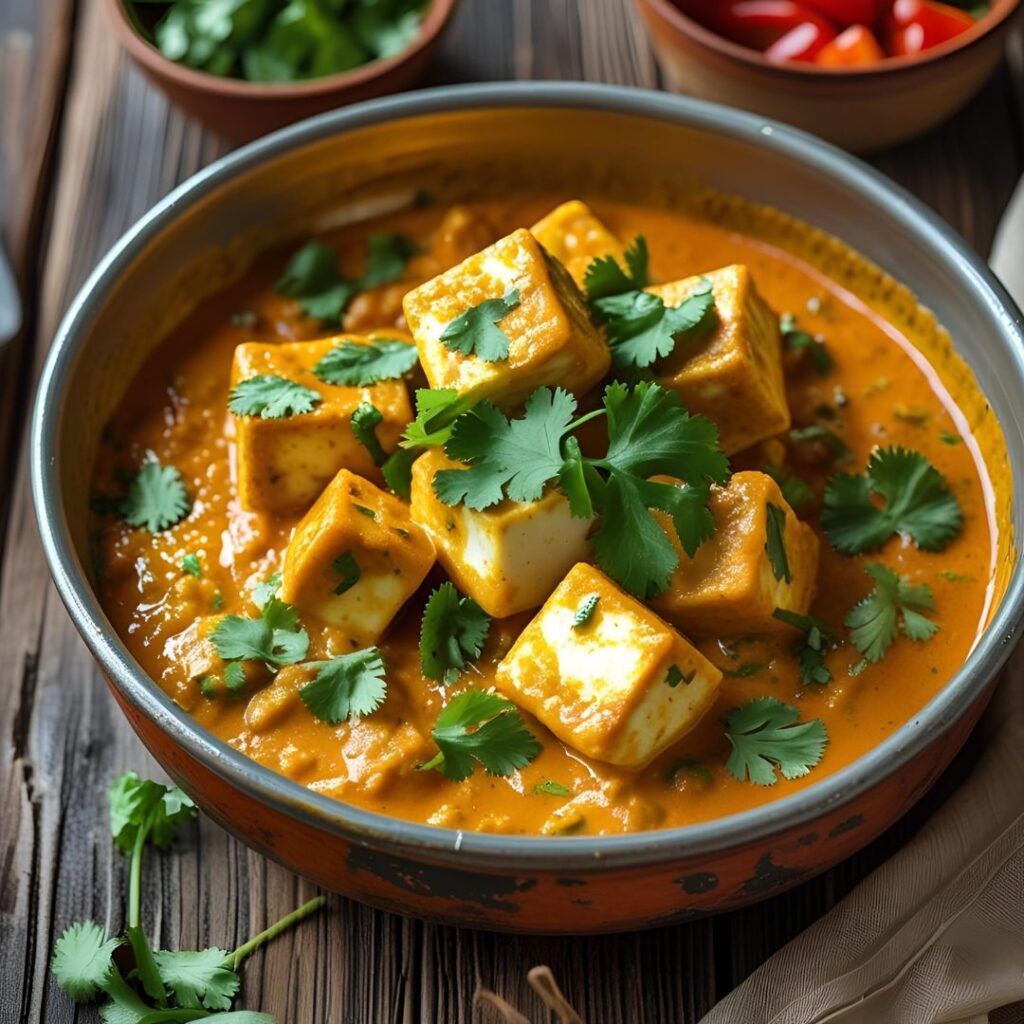

Paneer Lababdar Recipe: A Creamy Crown Jewel of North Indian Cuisine. Indian cuisine, renowned across the globe for its complexity and richness, offers a vast tapestry of flavors ranging from fiery and intense to mellow and comforting. Nestled somewhere in between is the exquisite Paneer Lababdar, a dish that embodies both opulence and balance. Rich in cream, tomatoes, aromatic spices, and featuring paneer—the quintessential Indian cottage cheese—Paneer Lababdar is a favorite across restaurants, home kitchens, and celebratory menus alike. Its luxurious texture and mildly spiced profile make it a beloved choice for vegetarians and food lovers seeking indulgence in every bite.
The name “Lababdar” has a poetic ring to it, and rightly so. It originates from Persian, where “lababdar” roughly translates to “a strong desire” or “utterly irresistible.” In culinary terms, it implies something so decadent and flavorful that it stimulates your taste buds and leaves you craving more. Paneer Lababdar lives up to that meaning with its rich, creamy, slightly tangy, and spiced gravy that perfectly coats soft chunks of paneer. Unlike dishes that rely heavily on heat or excessive spices, Paneer Lababdar is a study in refinement and balance.
Paneer is the soul of this dish. A fresh, unaged cheese made by curdling hot milk with lemon juice or vinegar, paneer holds a special place in Indian cuisine. It is protein-rich, soft yet firm, and holds its shape even when simmered in gravies. What makes paneer unique is its ability to absorb flavors while still maintaining its own subtle, milky presence. In Paneer Lababdar, the cheese is often used in two forms—cubed and grated—giving the dish a dual texture: soft bites paired with a creamy undertone, almost like a paneer emulsion enriching the gravy.
Paneer Lababdar stands out among paneer curries because of its uniquely balanced flavor profile. The base is made primarily of tomatoes, onions, cashews, and cream, creating a velvety, orange-colored sauce. While there is a gentle use of Indian spices like garam masala, coriander powder, and red chili powder, they are never overpowering. The dish also incorporates kasuri methi (dried fenugreek leaves), which lends it a subtle, smoky bitterness that complements the natural sweetness of tomatoes and cream.
The texture is luxurious—thicker than butter masala but smoother than kadai paneer. It is often described as having a "restaurant-style" consistency, which is silky, glossy, and spoon-coating, ideal for scooping up with naan or spooning over a bed of fragrant basmati rice.
Paneer Lababdar is a dish of indulgence, which is why it often makes an appearance during festivals, dinner parties, and weddings. Its name and nature both convey celebration. In many Indian households, especially in North India, it is a go-to paneer curry for special occasions—elevating even a simple meal to something festive.
What also makes it celebration-worthy is the dish’s visual appeal. The rich orange-red hue, creamy sheen on the surface, and vibrant garnish of coriander and cream make it instantly inviting. Whether plated for a wedding feast or served at a family gathering, Paneer Lababdar has that unmistakable “wow” factor.
While Paneer Lababdar doesn't have a singular point of origin, it draws heavily from the Mughlai style of cooking, which emphasizes richness, the use of nuts and cream, and subtle spicing. Cashew or almond paste is often used to give the gravy body, and the onions and tomatoes are slow-cooked and pureed for a smooth finish. The Mughal kitchens were known for their use of dairy, and Paneer Lababdar reflects this legacy in every bite.
Unlike the heavy meat-based Mughlai curries, this vegetarian adaptation brings the same grandeur in a gentler, more accessible form. It’s a brilliant example of how Indian vegetarian cuisine can match non-vegetarian dishes in flavor, texture, and visual richness.
For those familiar with Indian cuisine, it’s easy to confuse Paneer Lababdar with other paneer dishes like Paneer Butter Masala, Shahi Paneer, or Paneer Tikka Masala. However, each has its own distinct identity:
Paneer Lababdar, by contrast, strikes a middle ground. It is tangier than butter masala, more textured than shahi paneer, and less fiery than tikka masala. The inclusion of grated paneer into the gravy itself gives it a unique body and depth that few other curries offer.
It’s no surprise that Paneer Lababdar is a restaurant favorite, regularly featured on menus alongside dal makhani, palak paneer, and mixed vegetable curries. Its indulgent profile ensures it pairs well with both bread and rice, making it universally appealing.
At home, it has also gained popularity thanks to its manageable ingredient list and adaptability. You don’t need exotic or hard-to-find items—just pantry staples like tomatoes, onions, paneer, cream, and a few whole spices. Yet the end result tastes like something far more elaborate, making it a great choice for home cooks looking to impress without too much stress.
As Indian food has found fans all over the world, paneer-based dishes have gained global popularity, and Paneer Lababdar is no exception. Vegetarian diners abroad often find it to be a welcome alternative to meat-heavy mains. It is also increasingly being featured in modern fusion cuisine—used as a filling in wraps, sandwiches, or even pasta dishes for an East-meets-West experience.
For health-conscious eaters, variations of the recipe using low-fat cream or cashew milk are becoming popular. And for vegans, tofu or vegan paneer substitutes can be used, along with coconut cream or almond cream to maintain the dish’s character.
There’s a reason why this dish is named “Lababdar”—it has an undeniably irresistible charm. It’s creamy without being cloying, spiced without being harsh, and rich without being too heavy. Every spoonful is layered with the tang of tomatoes, the nuttiness of cashews, and the gentle heat of garam masala. The paneer absorbs all these flavors while adding its own creamy bite to the mix.
Whether you're new to Indian cuisine or a seasoned connoisseur, Paneer Lababdar offers a balanced, indulgent experience that never fails to delight.
1. Prepare the Masala Base (10–12 minutes)
2. Cook the Gravy (15–20 minutes)
3. Finish and Serve
Total Time Breakdown
Servings: 4 persons
One of the distinctive features of Paneer Lababdar is the use of both cubed and grated paneer in the same dish. While the paneer cubes provide a meaty bite and visual appeal, the grated paneer melts into the gravy and gives it a rich, creamy texture that makes the dish stand out. Adding grated paneer also helps to naturally thicken the sauce without relying too much on cream or cashew paste. Always add the grated paneer once the gravy is simmering and stir gently to incorporate it evenly. This dual-texture technique ensures every spoonful is velvety yet substantial.
The foundation of Paneer Lababdar lies in its onion-tomato-cashew paste, and how well this mixture is cooked will determine the final taste. After blending boiled onions, tomatoes, and cashews into a smooth puree, it’s crucial to sauté the paste until the oil starts to separate. This step, known as "bhunai" in Indian cooking, develops the depth of flavor and eliminates any rawness from the onions or bitterness from the tomatoes. Be patient during this process—it usually takes around 8–10 minutes on medium heat. Stir continuously and scrape the bottom of the pan to prevent sticking and burning.
Paneer Lababdar has a mildly tangy profile, primarily from the use of ripe tomatoes. However, an overly tangy dish can overshadow the creaminess and sweetness of the paneer and cream. To balance this, many recipes include a pinch of sugar or use sweet onions and fresh cream. If your tomatoes are very sour, consider adjusting with a bit more cream or a few extra cashews during blending. The key is to strike a perfect harmony where no single taste—sour, sweet, or spicy—dominates the others. Taste as you go and adjust seasoning accordingly.
Toward the end of the cooking process, a small amount of kasuri methi (dried fenugreek leaves) and garam masala can make a big difference in enhancing aroma and rounding out the flavor. Kasuri methi adds a subtle, earthy bitterness and a hint of smokiness, while garam masala contributes warmth and complexity. To get the best flavor, lightly crush the kasuri methi between your palms before adding it. This releases the essential oils and intensifies the aroma. Both ingredients should be added at the final simmer to avoid losing their fragrance in prolonged cooking.
Paneer is a delicate ingredient that can become rubbery if overcooked. Unlike meat or tofu, it doesn’t need long cooking times to absorb flavor. Once your gravy is cooked and seasoned, add the paneer cubes at the very end and let them simmer for just 2–3 minutes. If you prefer extra-soft paneer, soak the cubes in warm water for 10 minutes before adding them to the dish. This keeps them moist and tender. Over-simmering paneer not only toughens the texture but also risks breaking down the integrity of the cubes, making the presentation less appealing.
Paneer Lababdar is a North Indian curry made with paneer (Indian cottage cheese) simmered in a rich, creamy tomato-onion-cashew-based gravy. It is slightly spicier and more textured than Paneer Butter Masala, which is usually smoother, sweeter, and made primarily with butter and cream. Paneer Lababdar also includes grated paneer in the gravy, giving it a unique texture.
Grated paneer is added to the gravy to enhance its texture and richness. It thickens the sauce naturally and provides a slightly grainy, comforting bite. This technique also helps bind the gravy and paneer cubes together, making the dish heartier and more luxurious.
Yes, store-bought paneer works perfectly fine. However, if it's refrigerated or frozen, soak it in warm water for 10–15 minutes before using to restore softness and moisture. Homemade paneer can offer better flavor and texture, but good-quality packaged paneer is a convenient option.
If you’re looking for a healthier or dairy-free alternative to cream, you can use:
Each option gives a slightly different texture and taste but maintains the overall creaminess.
Paneer Lababdar is moderately spiced, not overly hot. The dish balances the tanginess of tomatoes, the richness of cream, and aromatic spices. You can easily adjust the heat level by increasing or reducing the red chili powder and green chilies, making it suitable for kids and spice-sensitive diners.
Yes. You can prepare the gravy in advance and refrigerate it for up to 2 days. Just add the paneer cubes and cream when reheating, shortly before serving. This keeps the paneer soft and prevents overcooking. The dish also freezes well if stored without cream and paneer, which should be added fresh.
Absolutely. Firm tofu is a great plant-based substitute for paneer. To replicate the creamy richness, use coconut cream or cashew cream instead of dairy cream. The taste will differ slightly but remains delicious and satisfying for vegans.
Paneer Lababdar pairs beautifully with:
Indian breads: naan, roti, kulcha, or paratha
Rice: jeera rice, basmati rice, or mild pulao
It is often accompanied by sliced onions, lemon wedges, and a side of raita or salad.
To reduce excess tanginess:
Avoid overusing tomato puree or canned tomatoes unless balanced with cream, sugar, or cashew paste.
Yes, this recipe scales very well. Just double the ingredients proportionally. When making in larger quantities, be mindful to adjust the seasoning and cook the gravy thoroughly to maintain depth of flavor. Add paneer and cream closer to serving time for the best texture.
Paneer Lababdar Recipe: A Creamy Crown Jewel of North Indian Cuisine. Rich in cream, tomatoes, aromatic spices, and featuring paneer—the quintessential Indian cottage cheese—Paneer Lababdar is a favorite across restaurants, home kitchens, and celebratory menus alike. Its luxurious texture and mildly spiced profile make it a beloved choice for vegetarians and food lovers seeking indulgence in every bite.
Enjoy the yum :)